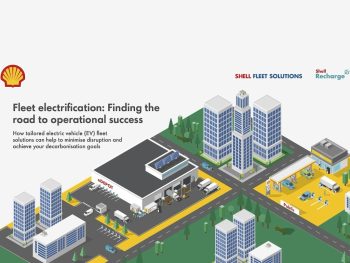A new report that can help fleets accelerate their electrification progress through practical solutions is now out from Shell Fleet Solutions.

Across the fleet industry, there’s a clear imperative to reduce environmental impact —and for businesses to start decarbonising today. For many, electrification can present a clear way forward. However, as fleets move toward electric vehicles, factors such as limited charging infrastructure and transition costs can create roadblocks.
The ‘Fleet Electrification: Finding the Road to Operational Success’ report can help fleets overcome such obstacles and find new ways to maintain operational efficiency and manage costs.
The report finds 60% of commercial road transport (CRT) and fleet businesses believe that the top action needed to have an impact on carbon emissions by 2030 is improvements in key infrastructure, according to Shell’s ‘Decarbonisation in Transport’ survey.
However, only 10% of transport organisations believe that the necessary infrastructure and resources are fully in place to support carbon reduction efforts.
Based on findings from the Shell Recharge Driver Programme 2024 report, EV drivers see a range of benefits from the transition, including improved environmental impact and the potential for reduced fuel costs.
Notably, the enjoyment of driving an EV has become a key and unexpected benefit for those who have used one, highlighting an element that is often overlooked when considering the facts and figures of a potential investment.
Insights in the report include managing the cost of the transition. More than half (52%) of fleet operators cite cost as a barrier to transitioning to EVs. Shell’s report outlines measures, such as semi-public networks and private eDepots with third-party access, to help increase fleet utilisation. Additionally, the report explores ways to mitigate initial expenditure, including financial support and utilising available incentives from policymakers and regulators in different markets.
The report also looks at how to maintain efficiency. Smooth EV operations require the right combination of public and private charging solutions. The new report details strategies that fleet operators could follow to keep their drivers or third-party subcontractors on schedule, especially on long routes for heavy-duty vehicles.
And the guide looks at the importance of working with the right partner. Transitioning to an electrified fleet is not an overnight process – nor is it one that fleet operators should seek to undertake alone. Working with a supplier who can provide end-to-end support, from cost-effective hardware to optimised eDepot utilisation, is key to a successful transition.
Shell Fleet Solutions’ full fleet electrification report is online here.

